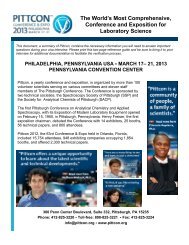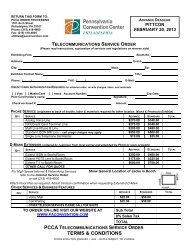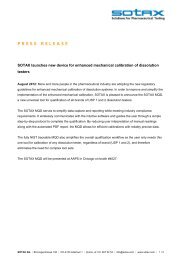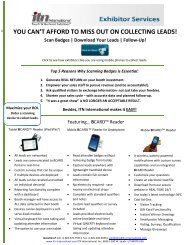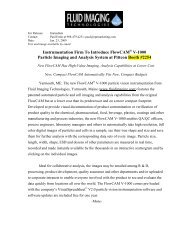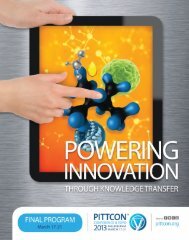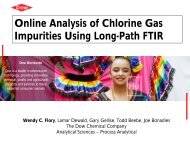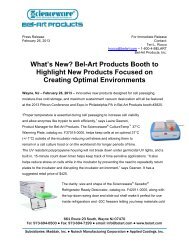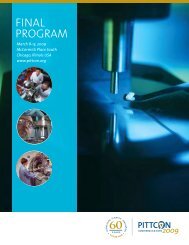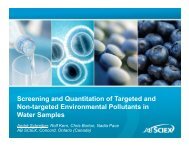2008 Pittcon Final Program - Pittcon Web Archives
2008 Pittcon Final Program - Pittcon Web Archives
2008 Pittcon Final Program - Pittcon Web Archives
Create successful ePaper yourself
Turn your PDF publications into a flip-book with our unique Google optimized e-Paper software.
EXHIBITOR NAME ROOM # DESCRIPTION<br />
2:00 p.m.<br />
“New EPA Methods for Bromate and Perchlorate Using Two-Dimensional Matrix Elimination IC”<br />
Abstract: Matrix elimination is a method of sample preparation that removes interfering matrix species<br />
prior to analysis. The process of matrix elimination for environmental samples is especially<br />
challenging due to the wide variety of matrices and analytes. For environmental contaminants<br />
applicable to ion exchange separation, matrix elimination has evolved from offline, labor intensive,<br />
sample preparation steps to automated on-line analysis, and finally two-dimensional applications that<br />
not only remove matrix interferences, but provide improved selectivity and increased sensitivity. This<br />
new, Matrix Elimination Ion Chromatography (MEIC) shows a four-fold increase in sensitivity for<br />
bromate and perchlorate analysis. This technique has resulted in the creation of two new EPA<br />
methods for drinking, waste-, and ground water analysis.<br />
3:00 p.m.<br />
“Biofuels Analysis: Meeting the Challenge of Quality Biodiesel and Bio-ethanol Manufacturing”<br />
Abstract: One of the biggest challenges facing the biofuels industry is the development of robust<br />
analytical methods for quality control of reaction processes and end products. This presentation will<br />
cover the products and solutions that Dionex offers to support biofuels analysis at each stage of<br />
production—from raw materials analysis to process monitoring and end product quality.<br />
4:00 p.m.<br />
“Automated Method Development with an HPLC System Optimized for Scouting of Columns, Eluents<br />
and Other Method Parameters”<br />
Abstract: In this session you will learn about a new integrated system that allows automatic and<br />
intuitive scouting of columns, eluents, and other important method parameters like column<br />
temperature. Up to two column selection valves in the column compartment provide high application<br />
flexibility. Intelligent software makes parameter permutations easy, without requiring method changes.<br />
Data mining tools help evaluating results and identifying optimal conditions.<br />
Wednesday, March 5, <strong>2008</strong><br />
10:00 a.m.<br />
“Setting Meaningful Detection and Quantitation Limits”<br />
Abstract: This session will cover concepts related to minimum limits for detection, quantitation, and<br />
reporting, and show how sound statistical techniques for setting appropriate limits can be easily<br />
implemented using Chromeleon® software. The Hubaux-Vos approach for setting detection limits will<br />
be explained, and a Chromeleon template for quickly determining EPA’s LCMRL (Lowest<br />
Concentration Minimum Reporting Level) will be shown.<br />
11:00 a.m.<br />
“Trace Analysis of Ions using AutoPrep”<br />
Abstract: Trace analysis is one of the more challenging techniques facing chemists in ion<br />
chromatography. Despite the ideal matrix, typically de-ionized ultra-pure water, there can be a<br />
daunting host of obstacles when faced with the need to analyze at detection limits that are routinely in<br />
the range of sub-ng/L. The name “AutoPrep” describes a series of automated steps used to prepare<br />
samples on-line. The preparation process can include steps to perform calibration, matrix elimination,<br />
concentration, or other techniques. AutoPrep processes samples using novel valve configurations and<br />
timing to achieve sample handling without direct sample contact by the end user, or analyst. The goal<br />
of AutoPrep is to mitigate the factors that contribute to contamination in Trace Analysis by isolating the<br />
sample from the external environment.<br />
12:00 p.m.<br />
“New Solutions for Routine Water Analysis”<br />
Abstract: This seminar will describe new solutions for routine monitoring of anions and cations in<br />
drinking water using basic ion chromatography systems. These solutions include the latest RFIC-ER<br />
technology for increased ease of use and consistent results. In addition, the determination of bromate<br />
and disinfection byproducts using RFIC-EG and two-dimensional IC methods will be discussed.<br />
1:00 p.m.<br />
“ASE for the Determination of Total Lipids in Complex Foods”<br />
Abstract: This presentation will focus on the use of ASE and the Dionium pathway for performing<br />
solvent extraction of acid or alkaline pretreated sample matrices.<br />
2:00 p.m.<br />
“Addressing the New Era of Food Safety Concerns”<br />
Abstract: Food safety is commanding increased public and policymaker attention, with emphasis on<br />
imports. Dionex recognizes the importance of food safety and the health risks that are associated with<br />
it. Dionex has developed solutions that address the public’s food safety concerns.



